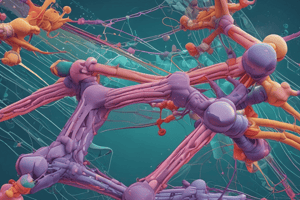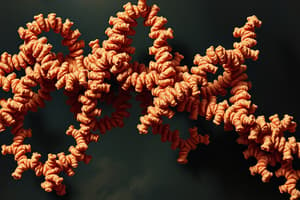Podcast
Questions and Answers
What is the main function of the CFTR protein?
What is the main function of the CFTR protein?
- Regulating electrolyte transport (correct)
- Regulating protein synthesis
- Regulating gene expression
- Regulating DNA replication
What is the result of the deletion mutation affecting phenylalanine 508 in CF patients?
What is the result of the deletion mutation affecting phenylalanine 508 in CF patients?
- Increased expression of CFTR
- Proper transport of CFTR to the cell surface
- Decreased expression of CFTR
- Degradation of CFTR instead of proper transport to the cell surface (correct)
What is the frequency of occurrence of Cystic Fibrosis in Caucasians?
What is the frequency of occurrence of Cystic Fibrosis in Caucasians?
- 1 in 100
- 1 in 2000 (correct)
- 1 in 5000
- 1 in 1000
What is the role of chaperones in the folding pathway of CFTR?
What is the role of chaperones in the folding pathway of CFTR?
What is the potential treatment for cystic fibrosis based on the therapeutical strategies mentioned?
What is the potential treatment for cystic fibrosis based on the therapeutical strategies mentioned?
What is the primary role of chaperones in protein folding?
What is the primary role of chaperones in protein folding?
What occurs when a signal peptide emerges during protein synthesis?
What occurs when a signal peptide emerges during protein synthesis?
What is the function of the translocon in protein export?
What is the function of the translocon in protein export?
What is a consequence of protein misfolding and aggregation?
What is a consequence of protein misfolding and aggregation?
What is the characteristic feature of signal peptides?
What is the characteristic feature of signal peptides?
Flashcards are hidden until you start studying
Study Notes
Posttranslational Modifications and Protein Function
- Proteins undergo posttranslational modifications that lead to functional activation, subcellular localization, secretion, or changes in activity/stability
- A protein's fate post-translationally depends on its structure, including sequence and conformation, which determine its interactions with modifying enzymes and cellular localization signals
Cystic Fibrosis (CF)
- Cystic fibrosis is an autosomal recessive disease prevalent in Caucasians, occurring at a frequency of about 1 in 2000
- The CF gene is 230 kb long and contains 27 exons that encode a 1480 amino acid protein called cystic fibrosis transmembrane conductance regulator (CFTR)
- CFTR is a cyclic AMP-regulated chloride channel with specific structural domains: two membrane spanning domains with six transmembrane regions each, two ATP-binding domains, and a regulatory domain with phosphorylation sites
- CFTR's folding pathway involves interactions with chaperones, and mutations can disrupt this process
Effects of CF Mutations
- CF mutations lead to defective electrolyte transport, affecting organs like the lungs, pancreas, and liver
- Thick mucous secretions cause chronic lung disease and infections, posing life-threatening risks
- In about 70% of CF patients, a deletion mutation affects phenylalanine 508, disrupting CFTR folding in the endoplasmic reticulum (ER), leading to degradation instead of proper transport to the cell surface
- Lower temperatures or chemical chaperones like glycerol can aid mutant CFTR folding and function in cultured cells
- Therapeutic strategies include drugs promoting chaperone interactions with mutant CFTR and aiding its folding and membrane transport, offering potential treatments for this form of cystic fibrosis
Protein Folding and Chaperones
- Many proteins can fold into their native conformation spontaneously, while others require assistance from chaperones
- Chaperones are proteins that reversibly bind to hydrophobic regions of nascent proteins or those in intermediate folding stages
- Chaperones aid proteins in achieving their functional conformation, stabilize intermediates, promote correct folding, and prevent misfolding or aggregation
- Chaperones can maintain proteins in an unfolded state for membrane passage, help unfold misfolded segments, and prevent inappropriate interactions with other proteins
- Chaperones may use ATP hydrolysis to carry out their functions, and failure to fold correctly often leads to rapid protein degradation
- Accumulation of misfolded proteins can lead to aggregation and contribute to serious diseases
Protein Export and Secretory Pathway
- Proteins destined for export or specific organelles like the plasma membrane, lysosomes, endosomes, or Golgi apparatus are synthesized on rough endoplasmic reticulum (ER)-bound ribosomes
- These proteins have a hydrophobic signal peptide near the amino terminus, typically consisting of a positively charged N-terminal region, a hydrophobic core of 8-12 amino acids in an α-helix, and a polar C-terminal segment serving as a cleavage site
- Translation starts on cytosolic ribosomes, and as the signal peptide emerges (15-30 amino acids), it binds to a signal recognition particle (SRP), halting translation
- The SRP, composed of six proteins and a small RNA molecule, binds to the signal peptide and GTP, forming a complex that moves to the ER
- The SRP then binds to an SRP receptor on the ER membrane, leading the ribosome to a translocon, a receptor that facilitates protein passage through the membrane
Studying That Suits You
Use AI to generate personalized quizzes and flashcards to suit your learning preferences.




